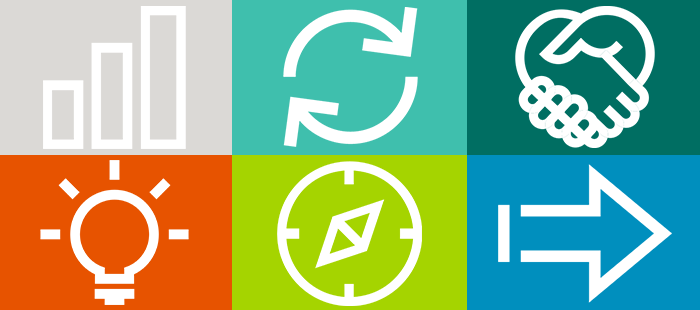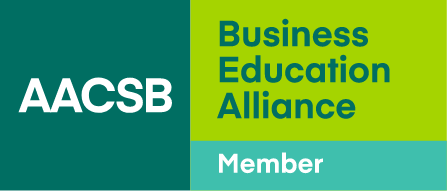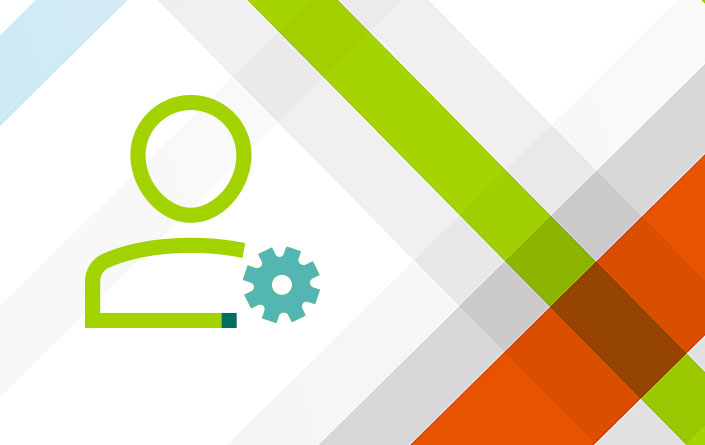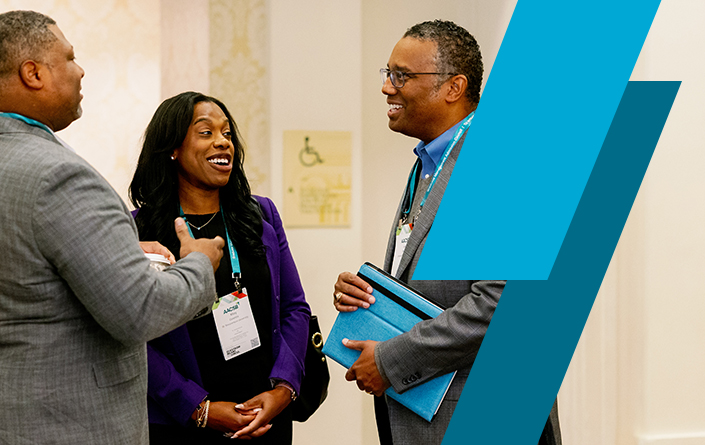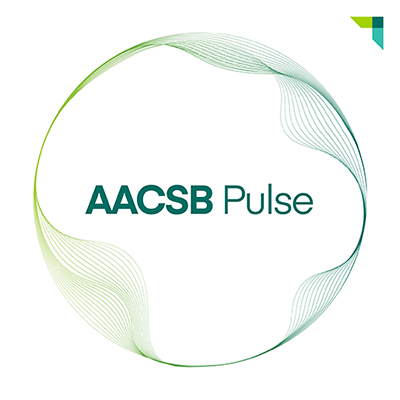Portals on Campus
Say the word "library," and most people will imagine rows of tall shelves laden with printed books and the scent of aging papers and ink. Those analog days of the academic library might not seem that long ago in real time, but they're eons ago in the context of the information age, when technologies are changing seemingly overnight. More of today's librarians are realizing that if they want to help their patrons navigate the complex and seemingly endless digital information landscape, they'll need to be more data scientists than archivists.
"I think the stereotypical image of a library as a place where people are hunkered down over printed reference books still plays out to some extent today," says Jason Sokoloff, head and strategic plan implementation coordinator at the Foster Business Library at the University of Washington in Seattle. "I still show people where our printed collections are. But at the core of what we do is helping people access information," he says. "We're connecting with faculty and students in whatever way we can to ensure they have access to the databases they need."
Of course, in today's information age, that effort to connect people with the resources they need, from wherever they are in the world, has grown ever more important. For example, in July, Arizona State University in Tempe announced its partnership with the Peace Corps to deploy its student-run initiative SolarSPELL, which stands for Solar Powered Educational Learning Library. Peace Corps volunteers can use SolarSPELL devices to set up offline wi-fi hotspots in remote and rural locations. These devices allow individuals with wi-fi-capable devices, such as mobile phones, to access ASU’s digital library content.
Founded by Laura Hosman, an associate professor at ASU, SolarSPELL currently has 365 digital libraries in eight countries across the Pacific Islands and East Africa. The partners hope that, eventually, thousands of Peace Corps volunteers will be able to set up offline, digital libraries in remote communities around the world.
SolarSPELL is just one example of how university libraries in general, and business libraries in particular, are reimagining their reach and purpose. These physical and virtual spaces are quickly evolving to help people not only better manage the growing onslaught of data, but also to access rich troves of resources from anywhere in the world. As libraries continue to improve the way they collect, organize, filter, analyze, recommend, interpret, and standardize data, they are becoming invaluable gateways between their communities and an increasingly complex and digitally driven world.
All the World's Data
Perhaps the biggest challenge that 21st-century libraries must face is the speed with which information is being created. No longer is it guaranteed that a book sitting on the shelf will be relevant in even a year or two—and that requires libraries to maintain a more fluid relationship with information than they have in the past.
Academic Business Library Directors (ABLD), an association of heads of business libraries across North America, addresses this new reality in its 2017–2018 year-in-review. In the report, aptly titled “The Data Swamp,” ABLD describes today’s abundance of data as “a rich, diverse, sometimes messy ecosystem” and libraries as places that help users solve complex problems that are difficult to analyze.
Sokoloff believes that the "next wave" of change for business librarians is to become data experts. "We're now exploring the opportunity to buy data sets and offer our librarians further professional development," he says, "so they can gain skills in programming languages and do some of the statistical analysis for our faculty themselves."
Even more pressing is the fact that students and faculty increasingly want unfettered access to data, as that data is updated in real time. "We're quickly moving away from being warehouses for books to being access points to data," says Hilary Craiglow, director of the Walker Management Library at Vanderbilt University's Owen Graduate School of Management in Nashville, Tennessee. "Increasingly, our students and faculty want to use programming, software tools, and machine learning. They want to discover customized meaning in that data and customize the way they visualize that data. The problems they are investigating are very current, so our librarians must stay very current in the information we provide."
The "next wave" for business librarians is to "gain skills in programming languages and do statistical analysis for faculty."—Jason Sokoloff, University of Washington
In response to these trends, the Walker Management Library has on its staff a business information and data analysis librarian, and it is building a portfolio of noncredit programs in technical subjects. Students can attend "lunch-and-learn" workshops on software tools such as Tableau and Github or regular seminars studying programming languages such as Python and R.
Earlier this year, before the pandemic hit, the Walker Management Library delivered its first certificate program in software computing. With only 20 slots available, the course opened for registration at 8:30 a.m. and was filled by 8:35. "We'll be learning a lot from this microcredentialing class," says Craiglow, "to see if it's something we should expand."
Like Vanderbilt's library in the U.S., the library at the Vienna University of Economics and Business (WU) in Austria is refining the ways it manages data for users, from recommending data for faculty to use in their lectures to finding ways to store handwritten documents digitally, says Nikolaus Berger, WU's library director. Moreover, libraries must contend with the fact that different departments on campus are using information across different platforms, based on different formats. The library's ultimate goal, says Berger, will be to deliver disparate data sets to its users via one point of access, in a single consistent format.
The purpose of business libraries, Berger adds, is not only to act as access points to information, but also to help manage its flow. "We have to find a way to standardize our data for the purpose of efficiency," Berger says. "We have 150,000 electronic books and 140 databases with millions of datapoints. People do not have the time to make inroads in so much data. We want people to think of us first if they have a problem to solve. Our professional staff can help them find good solutions."
The Library's Remaking
The adoption of digital technologies is driving many libraries to completely rethink the way they design and use their physical spaces. The authors of ABLD's 2017–2018 report found that 18 business libraries had planned or recently completed renovations of their facilities. These renovations have included converting spaces that were once used to store printed collections into study, office, collaboration, and classroom space.
For example, according to the report, the library at Michigan State University now includes a Digital Scholarship Lab that features more collaborative spaces equipped with display screens and wireless technology. A recent renovation of the Yale School of Management library includes "a new seminar room, map room with consultation space, AV studio for producing videos and web tutorials, and a variety of new study spaces for students with 65 additional seats."
In 2016, the HEC Montréal Library in Quebec, Canada, embarked on a revision of its entire business model. Its director, Bernard Bizimana, outlines the library’s transformation in “From Documents to Data: Reinventing the HEC Montréal Library,” a 2019 article published in The Academic Business Librarianship Review. The library’s staff realized that “the future of the Library was at stake,” Bizimana writes, because its community perceived it as “out of touch with the twenty-first century world of scientific inquiry.”
After that realization, Bizimana held meetings with the school's faculty and doctoral students, and the library's 22 staff members conducted seven focus groups with undergraduate and graduate students. From these conversations, the library staff determined that they would need to transition from "a document-centered model to a research data and knowledge management model." Today, the HEC Montréal Library has hired two full-time data analysts, and it has incorporated the school's computing and data mining laboratory. Soon, it will house the mathematics and statistics help center as well, and its librarians are thinking about offering workshops in statistical analysis, specialized databases, and data visualization technologies.
These moves aren't just physical changes, Bizimana writes, but an effort "to transform the Library into a data science and knowledge management hub where professors, researchers, and students can meet together and pursue their scientific goals."
The renovation of Vanderbilt's Walker Management Library was completed in 2017. Housed within the Owen School, the reimagined library space includes study areas and collaboration rooms equipped with presentation and conferencing technologies. "We even have a fireplace where we conduct intimate conversations with distinguished speakers," says Craiglow.
As WU in Austria planned its new campus, administrators asked a surprising question: Because information is increasingly digital, did the school need a physical library at all? Eventually, says Berger, they came to the conclusion that physical libraries are needed now more than ever to help users navigate the digital age. In fact, WU now dedicates 100,000 square meters—more than 1 million square feet—across six buildings to its library system. The library has retained most of its printed materials, but has moved them to lower levels. The rest of the building's open space is devoted to large gathering areas, meeting rooms, study rooms, and other spaces for learning.
"The role of our new building has completely changed with the ongoing digitization of materials."—Nikolaus Berger, WU
"Ten years ago, about 80 percent of the space in our old building was for storing print copies and about 20 percent was dedicated to learning spaces. In our new building, about 80 percent of the open space supports learning for the students," says Berger. "Our school is very teaching-oriented, so we must give our students spaces where they can learn, work, have a coffee, relax, and just be students. The role of the building has completely changed, keeping us aligned with the ongoing digitization of materials."
As they respond to the impact of COVID-19, libraries have had to engage in yet another rapid remaking of their products and services. To enable more users to access their resources remotely, the libraries at Vanderbilt and WU, for example, accelerated the process of scanning hard-copy materials into digital formats, purchasing more electronic books, and linking to additional electronic resources in all disciplines. The University of Washington is currently working out the details of potentially offering a new curbside pickup service for hard-copy materials.
'Partners in Education'
In many cases, changes in the business curriculum have led to changes in the way business libraries hire and deploy their staff. The business library at Pennsylvania State University in State College, for example, recently hired its first entrepreneurship librarian to support two new entrepreneurship programs offered through the Smeal College of Business.
Vanderbilt's Walker Management Library designs custom educational programs for each of the Owen School's degree tracks. It also assigns a librarian to each EMBA student team, and that librarian continues to guide the students throughout the entire program. Walker's business information and data analysis librarian helped a professor teach a session on the R programming language as part of an operations management course, while other librarians teach a short course on business research and an immersion course for students enrolled in the master's of accounting program.
The library even sponsors events to help students de-stress during finals. "In the fall, we brought in some baby goats, and in the winter, we did a pop-up hot chocolate stand," says Craiglow. In May, Vanderbilt's libraries put out a call asking the members of the community to share their reflections and accounts of the COVID-19 crisis, "in the form of emails, journals, social media posts, photos, videos, audio recordings or physical items," in order to create a historical record of the event.
In the past, one of Walker's librarians has held office hours in the undergraduate business minor office, and yet another serves as a mentor in the Wond'ry, Vanderbilt University's innovation center and maker space housed in the engineering and science building. "We want to make sure our community knows we're not the stereotype of a library," says Craiglow. "We want to break down barriers and be part of the community."
For its part, WU in Austria employs ten "liaison librarians," each with specialized knowledge of a business discipline; it assigns every new faculty member his or her own personal librarian, who provides teaching and research support. And at the University of Washington's Foster Business Library, librarians carve out time not only to speak to classes about the use of library resources, but also to consult one-on-one with students.
But the ideal, says Sokoloff, is for faculty to involve a librarian in the design of their courses so that information literacy is built in as a learning objective from the very start. "Our best instruction librarians are well-versed in good pedagogy and in the integration of information literacy into curricular development," he says. "We can introduce faculty to a host of new opportunities that they might not be aware of—we can be their partners in education."
Craiglow, too, would like more deans to ask their senior staff to integrate librarians into team discussions about research and pedagogy. "We can find efficiencies in the budget and help them locate and license premium content, not just for faculty research and student projects, but for the administration of the school," she says. "We already partner with the career center, with alumni relations, with the tech transfer office. If someone is tackling a problem that requires information, we can enhance that work."
Good Data, Better Decisions
Over the last decade, business schools have radically increased the number of topics they cover, from the traditional disciplines such as economics and strategy to the newer fields such as sustainability, corporate social responsibility, and data management. "There are hundreds of relevant fields," says Berger. "At least one member of my staff must know about these topics, because the library will have to buy the data sets and help people use those data sets. This is far different than dealing with printed books and paper journals." For that reason, Berger encourages his librarians to attend conferences for academic researchers in those fields, so that they "learn how faculty members work."
Going forward, as faculty request more specialized journals and data sets, libraries also will need to stretch their funding further—and in many cases, they'll need to weigh the needs of the many against the needs of the few, says Craiglow. "How do we justify funding an individual's subscription when our mandate is to provide information to the whole university?" she asks. "Libraries are going to have to figure out different ways to serve more customized projects that don't fit traditional funding models—that's as big a shift as the switch from printed books to databases."
For many academic libraries, this process has included ending or renegotiating their expensive contracts with publishers, in order to reduce their escalating costs and encourage more open access publishing. (See the "Battle Over Open Access" sidebar below.)
Even more important, the business library is becoming faculty’s best resource when it comes to teaching future leaders to become responsible consumers of information. Only by honing their information and data literacy can business leaders be effective decision makers, says Craiglow. “As they say,” she adds, “‘Bad data in, bad decisions out.’” The mission of today's business libraries is to serve as always-open portals to the 21st century’s never-ending flow of data—and to help students, faculty, and administrators convert that information into effective solutions for a complex and always changing society.
Sidebar
Battle Over Open Access
The push for the open access (OA) publication of academic research could be a game-changer for the world's business libraries. Today, in most cases, if faculty wish to make their research openly available to the public without subscription, they must pay publishers an Article Processing Charge, or APC. For that reason, even faculty who might prefer to publish in OA channels often opt to keep their costs low by submitting to traditional subscription-based journals. As a result, while a few OA publications exist in business disciplines, they are still the exception to the rule.
But the world's academic libraries could accelerate the adoption of OA far more quickly. Annual subscription fees to traditional journal subscriptions have skyrocketed—with some university libraries paying the equivalent of millions of dollars each year to provide their users with access to scholarly publications. Many library officials are calling these costs unsustainable, demanding that publishers do more to rein them in.
According to the Association of Research Libraries (ARL) based in Washington, D.C., many of its members have ended their contracts with Elsevier, one of the world's largest scientific publishers. For example, Iowa State University in Ames ended its so-called "big-deal contract" with the publisher—a contract that includes subscriptions to a large package of publications over multiple years. Instead, its library will subscribe to individual titles that are in highest demand by library users.
In April 2020, the University of North Carolina at Chapel Hill and the 64-campus State University of New York system also ended their big-deal contracts with Elsevier. Although these decisions had been in the works before the pandemic, the financial fallout from the crisis will place even greater pressure on the budgets of academic libraries—and lead other institutions to reassess their own publisher contracts.
"The COVID-19 financial fallout is highlighting the benefit of open access and the urgency of affordable subscription models that expand access in new ways," says Mary Lee Kennedy, ARL's executive director.
"Publishers of scholarly content need to recognize that while they might have monopoly power over their products, their primary customers face relatively flat budgets, and perhaps worse, in the current COVID-19 crisis," says Rebecca L. Mugridge, dean of University Libraries for the University at Albany, SUNY. "They must adjust their pricing practices for this ecosystem to maintain its balance."
In October 2019, the UNC–Chapel Hill successfully renegotiated its libraries' contract with Sage Publishing. The university worked out a "read-and-publish" agreement that covers the cost of open access publishing for its faculty. But the university had no choice but to end its contract with Elsevier, explains Elaine L. Westbrooks, university librarian at the school.
"We could not negotiate a license that aligned with our values: affordability, transparency, sustainability, and open access," says Westbrooks. "We will continue to build awareness regarding the complexities of a scholarly publishing ecosystem that is not working for anyone other than a select group of for-profit scholarly publishers. I look forward to sitting down with Elsevier ... or any other publisher that is open to rethinking how research universities can make their research open to all."
The COVID-19 financial fallout is highlighting the benefit of open access and the urgency of affordable subscription models."—Mary Lee Kennedy, ARL
The case that many academic libraries are still watching closely is the current negotiation between the University of California system and Elsevier. In January 2019, the UC library system allowed its subscriptions to Elsevier publications to lapse, before ending negotiations with the publisher as of February 28.
According to a UC statement, under Elsevier's proposed terms, the publisher would "capture significant new revenue on top of the university's current multimillion-dollar subscription, while significantly diminishing UC's rights to Elsevier content." Even as UC pursues its goal of 100 percent open-access publication for its faculty's research, university officials contend that UC would end up paying Elsevier an additional $30 million over the next three years.
In its counterproposal, UC demanded OA to be the default mode of publication for all UC scholars whose articles appear in Elsevier publications. The university proposed that its total payment would "consist of a reading fee and APC payments for each UC corresponding-authored article published." Elsevier's APCs can range from $150 to $6,000, depending on the journal's popularity. In addition, the university wants to pay no more in annual subscription fees than it had in its previous contract—which in 2018 amounted to nearly US$11 million.
In a response dated August 1, 2019, Nick Fowler, Elsevier's chief academic officer, addressed what he characterized as "inaccuracies" in UC's portrayal of the publisher's proposal. Fowler argues that while only 15 percent of the articles Elsevier publishes are open access, this relatively small percentage is driven by authors, not by the publisher.
"All 470,000 articles published by Elsevier in 2018 could have been published on an Author Pays basis if authors had chosen that option," he writes. "The challenge is not the goal of 100 percent Open Access, which is already fully possible. The stumbling block is how to get there." Fowler notes that Elsevier offered to hold the university's current fee structure steady to allow time for UC "to evolve its approach without incurring any more costs," but the offer was rejected.
In September, with no deal on the horizon, 30 UC faculty stepped down from Elsevier's editorial boards in protest, and UC's library system maintained access only to Elsevier's content published before 2019. But in July 2020, the university's publisher negotiations team announced that it had restarted negotiations with the publisher. The team hopes to reach an agreement to allow open access publishing of UC-authored articles by the end of this summer.
"The pricing for journal subscriptions had become exorbitant, so UC said, 'no more,'" says Jason Sokoloff of the University of Washington's Foster Business Library. "That was an enormous decision on their part, but UC has the power to do that in a way that smaller institutions do not. This is going to be a key moment as we wait to see how other academic libraries respond." The UC case has inspired other academic libraries to follow suit—including the University of Washington. As part of its 2018–2023 strategic plan, UW's library system is working to negotiate new terms with Elsevier, SpringerNature, and Sage Publishing. Those negotiations—in which UW calls for an increased emphasis on open access publishing and a cap on journal subscription fees—were still ongoing as of the publication of this article.
In UW's strategic plan, library officials note that "over time, publisher price increases have far exceeded the growth of library budgets, and ever-increasing percentages of collection budgets are now consumed by these inflexible contracts." They are advocating for more "open, public and emerging forms of scholarship." In another statement, UW's library officials note, "We are working in a landscape that asks us to think differently about how we approach these 'big deal' negotiations. We have reached a tipping point that has opened the door for new ways of working, exemplified by many of our [library] colleagues nationwide."
In 2016, the Vienna University of Economics and Business (WU) became a signatory to the Berlin Declaration on Open Access to Knowledge in the Sciences and Humanities, which supports and promotes open access to research. "WU sees it as part of its responsibility to society to provide the public with unlimited and long-term access to the academic work published by its researchers," according to a statement of the school's rector's council.
WU's library includes its own Open Access Office to help faculty with any issues related to publishing their research on open-access platforms. WU also benefits from a three-year agreement made with major publishers such as Springer and Wiley, arranged by the Austrian Academic Library Consortium and the Austrian Science Fund in 2017. Under the agreement, 22 institutions in the country pay for the APCs of their faculty's manuscripts, as well as a controlled subscription cost; in return, their users have access to all subscription journals from participating publishers. Elsevier does not take part in the agreement, explains WU's Nikolaus Berger, "but we are in negotiations."
Berger believes that it's possible for the industry to find a solution to escalating costs related to academic research—and to promote greater OA adoption—but it will not be easy. "Open access is a good idea, but publishers have turned open access into a business concept that they can sell. The question is, where will this lead us?" he asks. "Researchers will not be able to change the publishing market on their own. No matter what we do, publishing is costly—it is expensive to subject research to peer review and to publish it. But if more governments support open access, that could change things."

